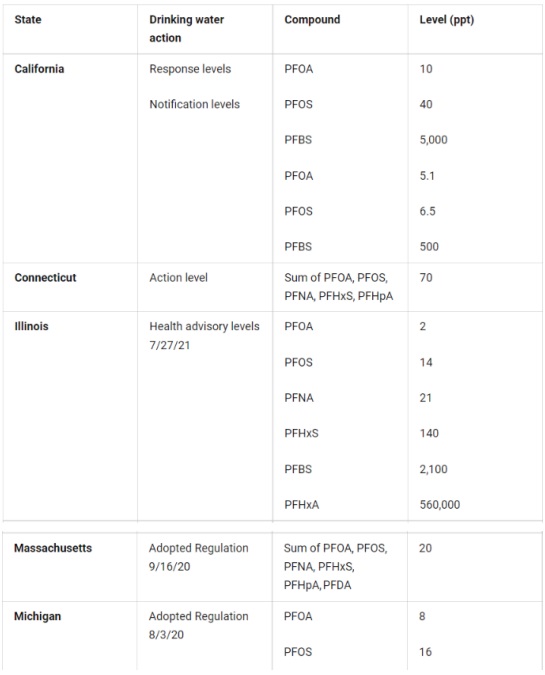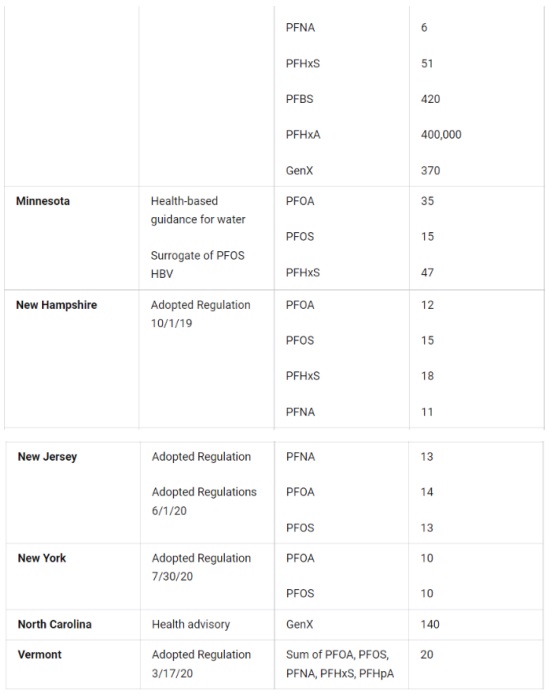Michael Scanlon, Jeff Civins, Nicolette Nunez, Vikki Marsh and Ann Al-Bahish from global law firm, Haynes Boone, look at the growing activity around the regulation of the so-called forever chemicals
Per- and polyfluoroalkyl substances (PFASs) are a group of several thousand manmade chemicals – perfluorooctane sulfonic acid (PFOS) and perfluorooctanoic acid (PFOA) are the best known – that began to be widely manufactured and used in the 1940s.
PFASs are fluorinated alkyl molecules with different functional groups, in which the hydrogen atoms have been replaced with fluorine atoms.
They are known as perfluorinated, where all of the hydrogen atoms have been replaced, and polyfluorinated when just a number of them have.
Although as a family PFASs have certain defining characteristics, chemicals within it also have different chemical and physiological properties. Generally speaking, however, PFAS molecules have a hydrophobic 'tail' that contains the carbon-fluorine bonds and a hydrophilic 'head' that includes the functional group. As such they are able to dissolve in both oil and water, and also form a coating that is resistant to oil and water. And, as California's State Water Resources Control Board points out, PFAS molecules with longer fluorinated carbon chains also have a "unique ability to reduce the surface tension of liquids". These chemical properties mean that PFASs are used in many industrial applications and consumer goods, including:
- firefighting foam;
- stain-resistant carpeting and upholstery;
- food wrappers; and
- non-stick coatings for cookware.
At the same time, the carbon-fluorine bond is one of the strongest and most stable in nature. Thus, PFASs have been dubbed 'forever chemicals' – meaning that they do not break down easily and persist in the environment. Their widespread use combined with this persistence have resulted in PFASs becoming ubiquitous. According to one report, published by the Centers for Disease Control and Prevention's (CDC) National Health and Nutrition Examination Survey (Nhanes), well over 90% of people in the US have some level of PFAS in their blood. While scientific understanding of the potential health effects is still developing, there is evidence suggesting that exposure and bioaccumulation may cause serious health conditions. The Agency for Toxic Substances and Disease Registry (ATDR) reports that they may increase cholesterol levels and risk of thyroid disease, lower infant birth weights, and decrease fertility in women. The full extent of how PFASs affect the human body is still to be determined.
How do federal environmental regulators control PFASs? Although Congress has been considering numerous PFAS-related measures that would amend existing environmental statutes or create new programmes, PFASs are not currently specifically regulated – with a couple of limited exceptions in:
- TSCA; and
- the Emergency Planning and Community Right-to-Know Act (Epcra).
Other federal environmental statutes that can regulate PFASs include the following administered by the EPA:
- the Safe Drinking Water Act (SDWA);
- the Comprehensive Environmental Response, Compensation and Liability Act (Cercla or Superfund); and
- the Resource Conservation and Recovery Act (RCRA).
Like other pollution programmes, the SDWA and RCRA authorise states, upon EPA approval, to assume the responsibility for their implementation (see Box).
How PFASs are regulated under various US environmental laws
TSCA
TSCA gives the EPA the authority to "require reporting, recordkeeping and testing requirements, and restrictions relating to chemical substances and/or mixtures." The agency has collected information on whether the risk from PFAS exposure is unreasonable and, thus, warrants regulation. Although it has yet to find that a PFAS chemical poses an unreasonable risk, it has negotiated voluntary phase-outs of PFOS and PFOA. It has also promulgated significant new use rules (Snurs) applicable to PFOA and related chemicals. These require a manufacturer to provide notice before reintroducing a phased-out chemical to commerce, even if it is for a previously specified use.
Epcra
This established the Toxic Release Inventory (TRI) reporting programme as a resource for learning about toxic chemical releases and pollution prevention activities reported by commercial and federal facilities. Since 2020, the National Defense Authorization Act has added 179 PFASs to the TRI list of reportable chemicals.
SDWA
The SWDA authorises the EPA "to set national health-based standards for drinking water to protect against both naturally occurring and manmade contaminants that may be found in drinking water". Regarding regulated contaminants, the agency generally promulgates regulations setting maximum contaminant levels (MCLs) and establishing monitoring, treatment and reporting requirements. And for unregulated contaminants, it can "issue health advisories that identify non-enforceable levels of contaminants in drinking water that are expected to be protective of sensitive populations". The EPA has not issued an MCL for PFASs, so there is no requirement to test for them in public water supplies. However, they are contaminants, and the SWDA authorises administrative orders and actions for injunctive relief upon receipt of information that a contaminant may present an imminent and substantial endangerment to health. Furthermore, the agency has issued health advisories for PFOA and PFOS, and it has used its SDWA emergency powers to respond where releases have been detected in public water systems. In early 2021, the agency published a list of contaminants, including PFASs, that may be in public drinking water, but which are not currently regulated. The EPA anticipates publishing a draft PFAS National Primary Drinking Water Regulation later this year, with the final regulation to be published in 2023.
Cercla
This act focuses on the clean up of inactive sites contaminated with hazardous substances. It imposes liability for any clean-up costs on arrangers and certain transporters of hazardous substances and on current and certain former owners of facilities, where hazardous substances were disposed. PFASs are not currently considered hazardous substances, so their presence in the environment is not a trigger for liability under Cercla. Therefore, unless the state has set regulatory clean-up levels, they are unlikely to be subject to the act's applicable or relevant and appropriate requirements (ARARs); instead, PFASs are addressed as pollutants or contaminants, with risk-based clean-up goals. The EPA may, however, conduct a removal action and provide for a remedial action, consistent with its National Contingency Plan (NCP) if there is a release or substantial threat of release into the environment that could present an imminent and substantial danger to the public health or welfare. There may also be a liability for remediating PFAS contamination under the NCP when this is associated with other contamination that is being cleaned up as a hazardous substance. In January, the EPA proposed a rule to the White House Office of Management to designate them as hazardous substances under Cercla. The agency anticipates that the proposed rule will be published this spring with the final regulation to be published by autumn 2023.
RCRA
The RCRA regulates the management of hazardous and non-hazardous solid waste. Regarding solid wastes, it bans open dumping and sets minimum requirements for the operation of municipal and industrial waste landfills. As to hazardous wastes, the RCRA provides the EPA with authority to regulate them "from cradle to grave", that is to say, from the moment of generation to their final disposal. PFASs are not currently considered hazardous wastes under the RCRA, so they are not subject to its hazardous waste management requirements. They are, however, solid wastes and subject to RCRA civil actions, by both governments and citizens, for injunctive relief when they present "an imminent and substantial endangerment to health or the environment". Last October in response to a petition from the governor of New Mexico, the EPA announced it will address PFAS under the RCRA.
What steps is the EPA taking to address PFASs?
In February 2018, the EPA issued an action plan detailing its strategy to address PFAS contamination. Under it the agency announced:
- plans to strengthen enforcement authority and clarify clean-up strategies by designating PFOA and PFOS as hazardous substances and developing interim groundwater clean-up recommendations;
- it is considering the addition of PFASs to the TRI under Epcra and its rules to prohibit the uses of certain PFASs;
- plans to move forward with the MCL process for PFOA and PFOS and to determine whether regulation is appropriate for a broader class of PFAS;
- plans to propose nationwide drinking water monitoring for PFASs under the next Unregulated Contaminant Monitoring Rule monitoring cycle;
- it is to rapidly expand the scientific foundation for understanding and managing risk from PFASs; and
- it plans to develop a risk communication toolbox that includes multimedia materials and messaging for federal, state, tribal and local partners to use with the public.
On 25 April 2019, the EPA released draft 'Interim recommendations to address groundwater contaminated with perfluorooctanoic acid and perfluorooctane sulfonate', including plans to:
- identify PFAS-contaminated sites, using a screen level that qualifies a site if it has a hazard quotient of 0.1 for either PFOA or PFOS, based on a no-effects level of 40 ng/L;
- use the PFOA and PFOS health advisories of 70 parts per trillion (ppt) as the preliminary remediation goals for groundwater that is a current or potential source of drinking water, where no state, tribal MCL, or other applicable and relevant requirements exist; and
- address levels of PFOA and/or PFOS over 70ppt where groundwater is being used for drinking water.
On 3 December 2019, the EPA sent a proposed regulatory determination for PFOA and PFOS to the Office of Management and Budget for interagency review as part of the process for establishing an MCL. That same month, it also published guidance for a federal clean-up programme for PFOA and PFOS. And the agency issued an advanced notice of proposed rulemaking to add PFASs to a publicly available database, where manufacturers can annually disclose the quantities of certain chemicals they release into the environment, recycle, incinerate, or otherwise dispose of.
On 26 February 2020, the agency issued an update to its PFAS Action Plan detailing its progress. It touted its:
- 22 November 2019 announcement that $4.8m in funding for new research on managing PFASs in agriculture had become available;
- 19 December 2019 publication of a new validated method to accurately test for 11 additional PFASs in drinking water, bringing the total to 29 PFASs;
- 19 December 2019 issuance of guidance regarding interim recommendations for addressing groundwater contaminated with PFOA and PFOS;
- 25 November 2019 issuance of an advanced notice of rulemaking that would allow the public to provide input on adding PFASs to the TRI under Epcra;
- 20 February 2020 issuance of preliminary determinations to regulate PFOA and PFOS in drinking water; and
- 20 February 2020 issuance of a supplemental proposal to ensure that new uses of certain persistent long-chain PFASs in surface coatings cannot be manufactured or imported into the US without notification and review under TSCA.
On 18 December 2020, the agency issued 'Interim guidance on destroying and disposing of certain PFAS and PFAS-containing materials that are not consumer products'. In this the EPA noted:
- three effective and commercially available technologies that can be used to destroy and dispose of PFAS-containing materials: thermal destruction, landfilling and underground injection;
- "The relative uncertainty associated with technologies' capabilities to control migration of PFAS to the environment is one of several factors that the public considers in determining how to destroy or dispose of PFAS-containing materials";
- landfilling, and particularly deep well injection, has fewer environmental uncertainties associated with it, but is limited to disposing of liquid-waste phase streams; and
- while interim storage itself is not a disposal or destruction method, it may be a useful immediate option until research reduces the uncertainties associated with the other disposal or destruction methods, such as hazardous waste combustors and other thermal treatments, including carbon reactivation units, sewage sludge incinerators, etc.
In October 2021, the EPA published the 'PFAS strategic roadmap: EPA's commitments to action 2021-2024', which provided dates for various agency offices to take specific actions, including:
- enhancing PFAS reporting under the TRI;
- establishing national primary drinking water regulations for PFOA and PFOS and leveraging the National Pollutant Discharge Elimination System to reduce PFASs to waterways;
- updating guidance on destroying and disposing of certain PFAS and PFAS-containing materials;
- building the technical foundation to address PFASs in air emissions; and
- evaluating and developing technologies for reducing PFASs in the environment.
The National Defense Authorization Act for fiscal year 2022 establishes a PFAS taskforce, requires testing for PFASs at military facilities, temporarily bans military incineration of PFAS-containing substances and requires public disclosure of results of water testing for PFAS, among other things.
How do state environmental regulators deal with PFASs?
In reaction to criticism about federal regulators' failure to act quickly, states have taken the lead in PFAS regulation. For instance, Washington and California have passed laws banning the substances in firefighting foam, and, as illustrated in the table below taken from the Association of State Drinking Water Administrators, several states have set PFAS-related drinking water standards:


Other states, including Maine, Pennsylvania, Rhode Island, Virginia, Washington and Wisconsin, are in the process of setting PFAS-related drinking water standards. And some states are addressing PFAS through non-regulatory approaches.
What litigation options are states pursuing to address PFASs?
States are bringing suits against PFAS manufacturers and users under environmental statutes based on imminent and substantial endangerment, as well as common law theories. A good example of this is the lawsuit asserting statutory and common law claims that Minnesota's attorney general brought against 3M, which settled for $850m. Although most of these suits are brought against PFAS manufacturers, New Mexico sued the US Air Force, alleging that its use of firefighting foam led to a PFAS and PFOA contamination of groundwater near the Cannon Air Force Base outside Clovis, New Mexico. In September 2020, a settlement was finalised, enforcing action against the base and requiring an administrative fee of $250,000. And on 7 April 2021, Alaska's attorney general also filed suit against 3M, Dupont, and 30 other named defendants on the same issue. In 2021 alone, more than 600 cases, including these state suits, were added to a multi-district litigation of these claims.
How do private actors address PFASs?
Both Cercla and the RCRA authorise citizens' suits when contamination poses an "imminent and substantial" danger, and some private litigants have been finding success in the courts. For instance, in Tennessee Riverkeeper, Inc v 3M Co, 234 F Supp 3d 1153 (ND Ala 2017), an environmental organisation's suit under the RCRA's citizen-suit provision made it to the discovery stage on the issues of whether PFASs are a hazardous waste and whether the plaintiffs could establish imminent and substantial endangerment.
Similarly, in Little Hocking Water Association, Inc v EI du Pont Nemours & Co, 91 F Supp 3d 940 (SD Ohio 2015), a non-profit water provider's suit under the RCRA's "imminent and substantial endangerment" citizen-suit provision survived a motion for summary judgment.
Plaintiffs are also bringing cases under common law causes of action, including negligence, product liability, nuisance and trespass. The best known of these involved lawsuits against DuPont for PFAS contamination from its Washington works plant in West Virginia on the Ohio River. A class action brought in West Virginia state court settled for $235m for health monitoring and $70m for health and education programmes. Individual claims were then brought in an Ohio federal court and settled after several bellwether trials for a lump-sum payment of $671m and up to $50m per year to handle additional costs.
In Thelma Benoit, et al v Saint-Gobain Performance Plastics Corp, 2017 US Dist LEXIS 121734 (NDNY 2 Aug 2017), the district court cited prior cases in holding that it is sufficient to allege that a "clinically demonstrable presence of toxins" in a plaintiff's body is a physical injury under a claim for personal injury.
But the appeals court in Benoit deferred for a possible future ruling whether two of the plaintiffs – who are without elevated levels of PFOA in their blood and whose only tort with a present 'injury' alleges harm to property – can pursue medical monitoring. The lower court's interpretation of Caronia v Philip Morris USA, Inc, 22 NY 3d 439 (2013) on that matter "may or may not be correct", the appeals court says. "We think that whether New York law will allow medical monitoring to be ordered solely on the basis of damage to property is unclear, but that that issue is not ripe for resolution." [Benoit v Saint-Gobain Performances Plastics Corp, 959 F3d 491 (2d Cir 2020)].
President Biden's plan to address PFASs
On 18 October 2021, the Biden administration launched its strategic plan to combat PFAS pollution. This includes a multi-agency approach, including collective efforts from the Food and Drug Administration (FDA), US Department of Agriculture (USDA), Department of Transportation (DoT), Department of Defense (DoD), Department of Homeland Security (DHS), Department of Health and Human Services (DHHS), White House Council on Environmental Quality (CEQ) and the EPA. Some notable highlights of the plan are:
- the EPA is to monitor 29 PFAS compounds in drinking water via the Unregulated Contaminant Monitoring Rule (UCMR 5) programme;
- the FDA and USDA are to expand food supply testing and reporting to better understand dietary exposure to PFAS;
- a bipartisan infrastructure deal to address emerging contaminants through the State Revolving Funds and small and disadvantaged community programmes; and
- the DoD is to swiftly address PFASs at its sites throughout the country with clean-up assessments completed by 2023.
PFASs are hazardous and dangerous contaminants affecting the lives of millions. The attention given to cleaning up these chemicals and implementing infrastructure to mitigate their harmful effects, and particularly within the Biden administration, is a hopeful prospect for the future.
Originally Published by Chemical Watch
The content of this article is intended to provide a general guide to the subject matter. Specialist advice should be sought about your specific circumstances.
[View Source]




